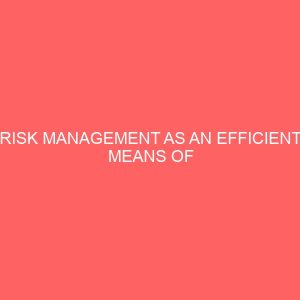Description
ABSTRACT
Evaluation of the impact of large numbers approach in the valuation of life assurance business using industrial general insurance as a study. the statement of problem ranging from the fact that life assurance valuation has not been adequately impact on the economy, also good valuation model improves the profitability of life assurance firm, also the principles of large numbers p[lays a significant impact on life assurance valuation. The objective of the study is to determine the impact of life assurance valuation on the economy so as to know whether it can improve companies’ through primary and secondary means and the research instrument used was questionnaire covering the statement of the problem. The population selected for the study was 100 staff of IGI and data for this work is presented using table and is analyzed using simple percentage. At the end, the researcher discovered that life assurance valuation impacts on the economy, improves companies profitability. In recommendation, the researcher suggested that benchmarking will help large number principle valuation. And also, valuation of life assurance business should be regulated.
TABLE OF CONTENTS
Title Page – – – – – – – – – –
Approval Page- – – – – – – – – –
Dedication– – – – – – – – –
Acknowledgement- – – – – – – – –
Abstract- – – – – – – – – – –
Table of content — – – – – – – –
CHAPTER ONE
INTRODUCTION
1.1 Background of the study — – – – – –
1.2 Statement of the Problem– – – – –
1.3 Objective of the study- – – – – – –
1.4 Research question- – – – – – – –
1.5 Research Hypothesis- – – – – – –
1.6 Significance of the study — – – – – –
1.7 Scope and Limitation of the study – – – – –
1.8 Definition of operational terms- – – – – –
References– – – – – – – – –
CHAPTER TWO
LITERATURE REVIEW
2.1 An overview — – – – – – – –
2.2 History and development of life
assurance in Nigeria – – – – – – –
2.3 The forces driving development of life
assurance policy– – – – – – –
2.4 Development of life Insurance in
the economic in transition – – – – – –
2.5 The life insurance market in the economic
in transition- – – – – – – – –
2.6 Reason for determining the value
of Life Insurance Company- – – – – –
2.7 The effect of insurance business
in economic development in Nigeria. – – – –
2.8 The difficulties surmounted by life assurance – – –
2.9 Challenges and prospects of life
insurance business- – – – – – –
2.10 Valuing of life insurance company- – – – –
2.11 Four major reasons behind Nigerians negative
attitude to insurance services business. – – –
2.12 Scope and meaning of life assurance– – –
2.13 Factors affecting life assurance market- – – –
2.14 Key benefit of life insurance- – – – – –
CHAPTER THREE
RESEARCH METHODOLOGY AND DESIGN
3.1 An overview — – – – – – – –
3.2 Sources of data- – – – – – – –
3.2.1 Primary source of data — – – – – –
3.2.2 Secondary data- – – – – — – –
3.3 Population of study- – – – – – — –
3.4 Sample size and sampling techniques- – – –
3.5 Instrument used in selecting sample size- – – –
3.6 Validity and reliability of the instrument used- – –
3.7 Method of data presentation and analysis- – –
CHAPTER FOUR
DATA PRESENTATION, ANALYSIS AND
DISCUSSION OF FINDINGS
4.1 An overview– – – – – – –
4.2 Data presentation- – – – – – –
4.3 Data Analysis- – – – – – – –
4.4 Testing of Hypothesis- – – – – –
4.5 Discussion of findings- – – – – –
CHAPTER FIVE
SUMMARY OF FINDINGS, CONCLUSION
AND RECOMMENDATIONS
5.1 Summary of Findings- – – – – –
5.2 Conclusion – – – – – – – –
5.3 Recommendations- – – – – – –
5.4 Suggestion for further study- – – – –
Bibliography- – – – – – – – –
Appendix- – – – – – – — – –
Sample Questionnaire- – – – – – –
CHAPTER ONE
INTRODUCTION
1.1 BACKGROUND OF THE STUDY
Traditionally life assurance companies have reported financial result to shareholders on the basis of the statutory requirements of the insurance companies’ legislation. So the most common measure of a life insurance company’s financial year was the statutory earnings from operation. This convenient measure since it also represents the amount of money which can be paid to policyholder or paid in the form of dividends.
The major disadvantage to relying upon statutory earnings as a measure of how well a company is doing is that statutory accounting tends to be designed to protect against insolvency and therefore, by its very nature, suffers from ovens conservatism.
Statutory earnings do not measure well a company is doing on a going concern basis. For example, capital invested in acquiring business (Acquisition of profitable new business results in an immediate “Loss” followed by a subsequent enhanced series of profits.
Although suitable for solvency testing, the statutory approach, by charging the “Capital” cost of new business to revenue and ignoring the future surplus stream attributable to new business, fails to display in any accounting period a meaningful account of trading activity of that period for most products, a slowdown in sales will result in an immediate increase in statutory earnings and generally, most would not regard slowdown in sales as being a sign of a healthy company. So, it is as that statutory earning is the wrong method to measure the health of the company.
Largely, as a result of the inadequacies of statutory accounting, US insurers were required by the securities exchange commission in the early 1970’s to begin to report earnings to shareholders on a generally accepted principles (GAAP) basis.
The major advantages of GAAP accounting is that it does attempt to produce earnings that reflect how well or how badly the insurance company had performed in a form, which is useful to management. With GAAP, generally an increase in sales will not depress GAAP earnings to the same degree, as it would statutory earnings.
Unfortunately, because 100% of acquisition costs are deferred, increased sales will still depress GAAP earnings to some extent. Additionally, margins for conservation are normally introduced into the assumption, and GAAP might suffer from the lock-in principle. Once assumptions are set for a particulars generation or branch of business, the assumptions cannot be changed unless future losses are life. Another major disadvantage to GAAP is that GAAP earnings may very significantly between two identical companies depending on the objectiveness of management in establishing assumption. Therefore, overall, GAAP is not a good prognostication for how well a company is doing.
During the period of fluctuation in interest rates, which occurred in the US during the mid-1970s and early 1080s some US corps began to look at cash flows as a measure of “how well” their companies were doing.
1.2 STATMENT OF THE PROBLEMS
The following are the problems which has been existing that initiated my zeal to research on the above topic.
1. Life assurance valuation has not impacted adequately on the economy.
2. Good valuation model improves the profitability of life assurance form.
3. The principle of large numbers significantly impact on the assurance valuation.
4. inadequate impact of life assurance valuation on the development of the economy.
1.3 OBJECTIVE OF THE STUDY
The aim of this research work is to examine the impact of large numbers approach to the valuation of life assurance business with particular reference to IGI life Enugu Office. The specific objectives of this research work are as follows:
1. To determine the impact of life assurance valuation on economic development of Nigeria.
2. To determine the impact of this methods on the profitability of life assurance business
3. To know if the principle of large numbers has any significant impact on life assurance valuation.
4. To evaluate the various approaches of valuations and their importance.
1.4 RESEARCH QUESTION
Based on the statement of problems and objective of the studies, the following are my research questions:
1. Do you think that life assurance valuation has impacted adequately on the economy?
2. Does the method of valuation improve profitability of a life assurance firm?
3. Can the principle of large number matter in life assurance valuation
4. Is there any importance of the valuation model?







